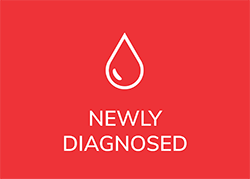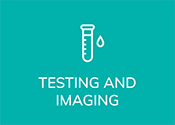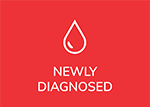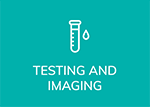Home » CLL / SLL Patient Education Toolkit » Imaging Tests
Imaging Tests
In science and medicine, information is constantly changing and may become out-of-date as new data emerge. All articles and interviews are informational only, should never be considered medical advice, and should never be acted on without review with your health care team.
A variety of tests are used to capture images inside the body when chronic lymphocytic leukemia (CLL) and small lymphocytic lymphoma (SLL) are present. Imaging tests are used to look inside the body to capture pictures that will help the healthcare team visualize what, if any, internal changes might be occurring. These tests are usually performed in either a hospital, specialty clinic, or imaging center, and are typically read first by a physician who has specialized in radiology. Imaging tests only provide one piece of information that can be used in combination with a complete medical history, physical exam, blood work, and other tests to help provide a clearer assessment of overall physical health.
What Are the Most Common Types of Imaging Tests Used?
The main types of imaging tests used for the disease include the computed tomography (CT) scan, positron emission tomography-computed tomography (PET- CT) scan, magnetic resonance imaging (MRI) scan, and although not a primary imaging tool in management, ultrasounds are sometimes used. CT scans are the most commonly used imaging technique in CLL and SLL.
What Is a CT Scan and How Is It Used?
This test involves taking multiple X-ray images and using a computer to combine them into a detailed image of the body. The images produced show bones, organs, and soft tissues more clearly than standard X-rays. It is commonly used for the management of the disease because it helps healthcare providers to better visualize various organs. They are useful in evaluating the growth of lymph nodes, spleen, and liver, as well as keeping track of the effectiveness of treatment and detecting any potential complications or secondary cancers.
CT scans are generally not needed for diagnosis because this is usually confirmed with simple blood testing and occasionally a bone marrow biopsy. They should not be used routinely at the time of diagnosis nor without a specific indication. CT scans may be appropriate when there are new symptoms such as swollen lymph nodes and/or suspicion of an enlarged spleen or liver. They are also sometimes utilized before starting certain treatments to identify baseline measurements of internal organs or in clinical trials to answer specific research questions. CT scans are most often performed in an outpatient or radiology clinic setting where they are performed by a radiology technologist. CT scans are painless, although some people find it uncomfortable to hold still in certain positions for minutes at a time while the machine is capturing a clear image. CT scans take approximately 10 to 30 minutes to complete.
What Is a PET-CT Scan and How Is It Used?
This test is a specialized type of scan that is done in combination with a CT scan. It not only shows images of structures and organs but also reveals how metabolically active certain tissues in the body are. During this test, a small amount of radioactive tracer is injected into a vein through an intravenous (IV) line. The radioactive tracer highlights areas that have abnormally high metabolic activity, such as rapidly growing cancer cells.
Suspicion of the development of a rare but serious complication of the disease called Richter’s Transformation (which is when the cancer transforms into a significantly more aggressive form of large cell lymphoma and is usually characterized by aggressive lymph node growth and other symptoms) is the only time the use of a PET-CT scan may be indicated for those with CLL and SLL, but a biopsy is then always needed to prove the diagnosis. It is also sometimes used in clinical trials to monitor the effectiveness of investigational therapies.
Similar to CT scans, this test is most often performed in an outpatient or radiology clinic setting where it is performed by a radiology technologist. PET-CT scans are also painless, and remaining still in certain positions for minutes at a time while the machine is capturing a clear image can be uncomfortable for some. This test takes approximately 30 minutes to produce detailed images. Occasionally, depending on the individual, additional scanning may be required which makes the test take a little bit longer.
What Is an MRI Scan and How Is It Used?
This test uses magnetic fields and radio waves to generate images, so it has the advantage of there being no ionizing radiation involved like there is with CT, PET- CT, and plain X-rays. The images may have slightly lower resolution compared to CT scans. An MRI poses no radiation risk and often provides invaluable diagnostic information for many disorders. However, for CLL and SLL the added benefit as compared to CT alone is extremely limited and it is the most expensive testing modality.
An MRI is also most often performed in an outpatient or radiology clinic setting by a radiology technologist. However, the time in the machine to obtain images takes much longer than CT or PET-CT scans. It can last up to 60 minutes on average, depending on the body part being scanned and the type of machine being used. Individuals must remain perfectly still for the machine to capture clear images, and any small movements will result in a longer procedure time. This test is also painless, but due to the need to remain very still some individuals will find it uncomfortable.
It’s very important to tell your healthcare provider and the radiology technologist if you have any form of metal in your body. This includes surgical clips used for brain aneurysms, cochlear (ear) implants, metal stents put inside blood vessels, staples, screws, plates, artificial joints, metal fragments (such as shrapnel, tattoos or permanent makeup), artificial heart valves, implanted infusion ports, implanted defibrillator or pacemaker, nerve stimulators, and so on. An MRI is considered safe for individuals who have well-fixed joint replacements made of non-iron containing materials such as titanium. If there are any other metals present in the body, the individual should not even enter the MRI scanning area unless told to do so by the radiology technologist who has been made aware of any metal that is present in the body. The test is normally performed in a small tube-like enclosed structure, so if individuals have claustrophobia, they may need to take medicine to help relax while in the scanner. In some cases, an open MRI machine is an option that allows for more space around the body.
What Is an Ultrasound Scan and How Is It Used?
Although not a primary imaging tool used for disease management in those with CLL and SLL, ultrasounds may be used to evaluate specific conditions or complications associated with the disease. This test uses high-frequency sound waves to obtain real-time images or video capture of internal organs and other soft tissues. This can include the spleen, liver, and superficial lymph nodes, especially those located in the neck, groin, or axilla (underarm area). Ultrasound is also sometimes used to guide other procedures such as biopsies, placing central lines, aspirating fluid, or detecting complications such as blood clots and certain secondary cancers. It is used much more in Europe and has the advantage of being much less expensive compared to other types of imaging tests. This test is usually very quick, painless, and does not require any special preparation. Ultrasound does not involve radiation, so it is considered the safest imaging modality. However, it has many limitations, including the inability to visualize structures located deeper within the body (especially in individuals with larger body sizes). Ultrasound is also operator-dependent and relies on the sonographer to obtain high-quality images, as opposed to CT or MRI which are more automated and standardized.
Why Is Dye Sometimes Used with Imaging Tests and Are There Any Associated Risks?
CT, PET, and MRI scans are sometimes performed using contrast dye or radioactive tracers to capture clearer images. Contrast dye is made of a naturally occurring chemical element known as iodine which is administered through an intravenous (IV) catheter that is inserted into a vein.
Some people can have an allergic reaction to the contrast dye or radioactive tracers. Ask your healthcare team if the use of these materials will be used, and be sure to let them know if you have ever had an allergic reaction to contrast dye, seafood, iodine, or radioactive tracers in the past. Possible reactions can include rash or hives, nausea, wheezing, shortness of breath, itching, or facial swelling that can last up to an hour. These symptoms are usually mild and most often go away on their own.
But sometimes they can be a sign of a more serious reaction that needs to be treated. In rare cases, a severe, life-threatening allergic reaction that causes low blood pressure or trouble breathing can occur. If there is a known risk of an allergic reaction, a very small test dose of the contrast dye or radioactive tracer may be given first, and medications can be administered prior to the test (usually a steroid like prednisone) to help prevent another reaction. Sometimes these preventative medications need to be started the day before the scan.
Additionally, since both contrast and radioactive tracers are eliminated from the body through the kidneys there is a small risk of kidney damage from these substances. This is a rare occurrence, but it is more common in someone whose kidneys already do not work well. In most cases, the kidney damage is mild and resolves on its own within a few days. If a scan with contrast dye or radioactive tracers is needed, a blood test may be done firsts to check kidney function. IV fluids or medications can be administered to help the kidneys eliminate the substances more rapidly.
Are There Any Other Risks Associated with CT, PET-CT, MRI, or Ultrasound Scans?
All these imaging tests are generally safe. CT and PET-CT scans can pose a risk of cellular damage with repetitive exposure to the ionizing radiation that is used (in CT technology) and radioactive tracers (in PET scans). The risks associated with imaging tests increase with frequent scans, so it’s important to only receive them when there is a specific need to do so. The resulting cellular damage from repeat exposure can lead to secondary cancers (including lymphomas). It is important to note that the risk of death from radiation-induced cancer is very small in comparison to the chance of death from CLL and SLL if the disease is not closely monitored and managed appropriately. The design of clinical trials may include (and require) frequent imaging scans. If an individual with CLL or SLL is considering enrollment in a clinical trial, asking what kind of imaging will be required, and how often, is an important factor to take into consideration.
The use of CT, MRI, and PET scans can be valuable tools. However, the decision to use them should only be made after weighing the potential risks and benefits, and they should only be performed when there is a convincing reason. Repetitive imaging should be performed cautiously due to the increased risk associated with exposure to ionizing radiation and radioactive tracers. Therefore, imaging strategies must be individualized based on specific clinical circumstances and should not be performed on a routine basis. Additionally, there is no role for imaging at the time of diagnosis as part of a routine workup unless there are lab results or other symptoms that warrant further investigation.

















